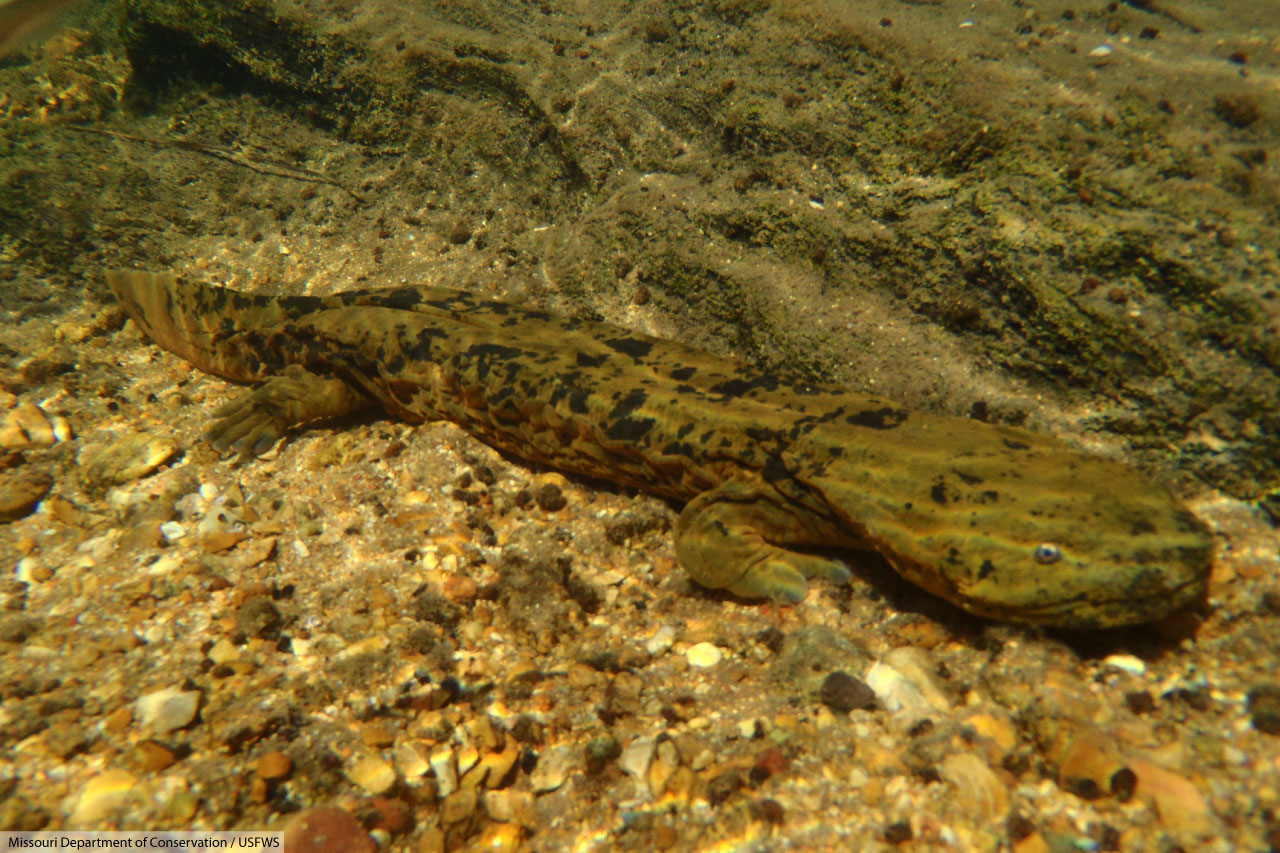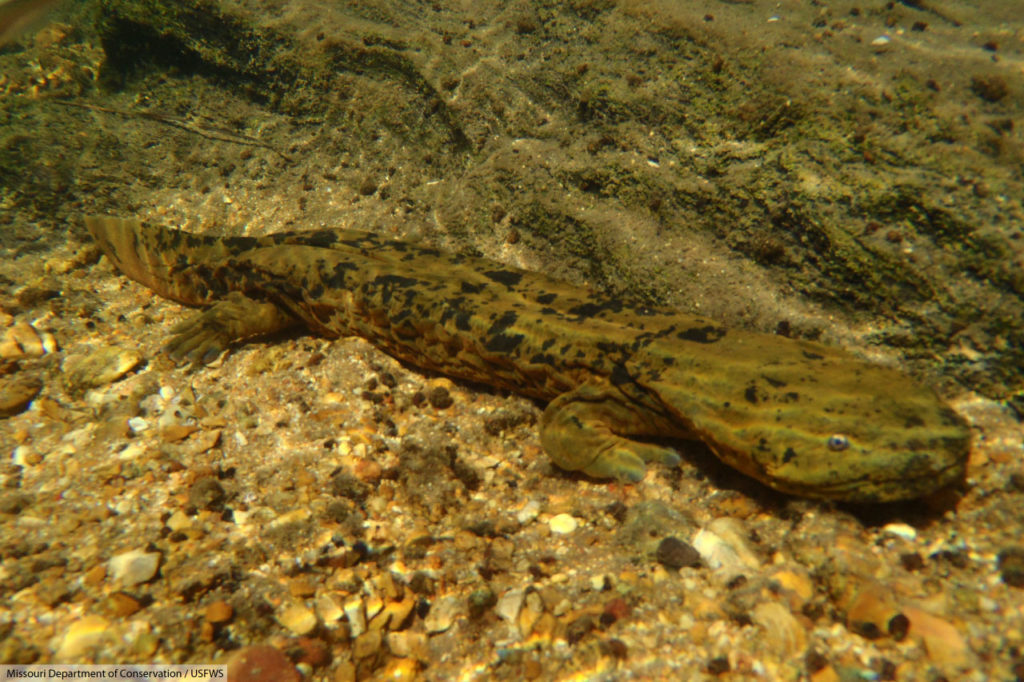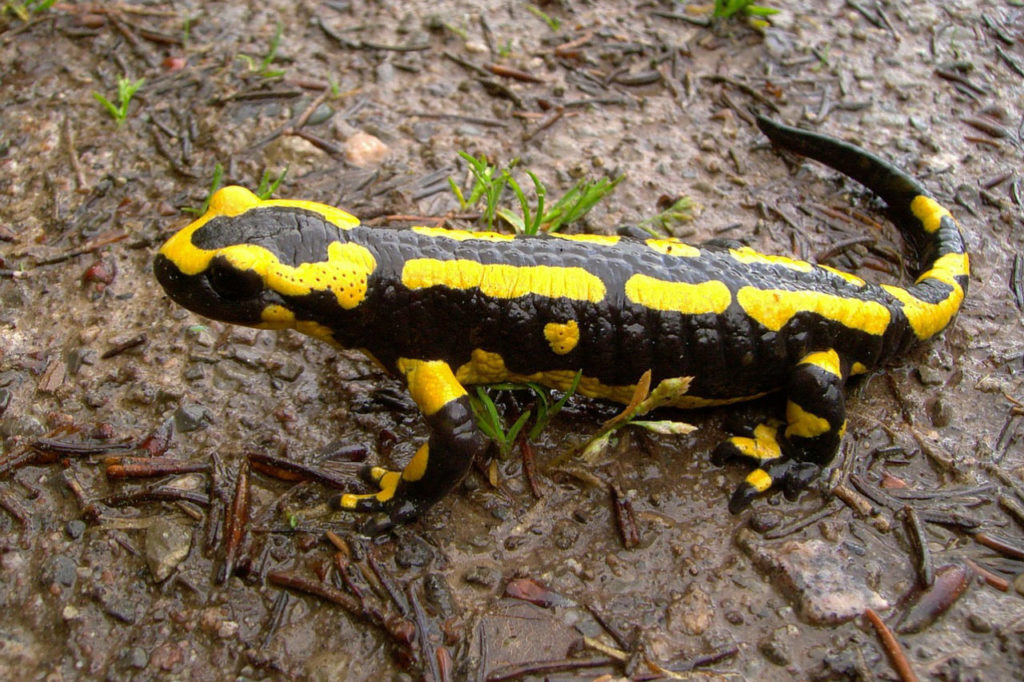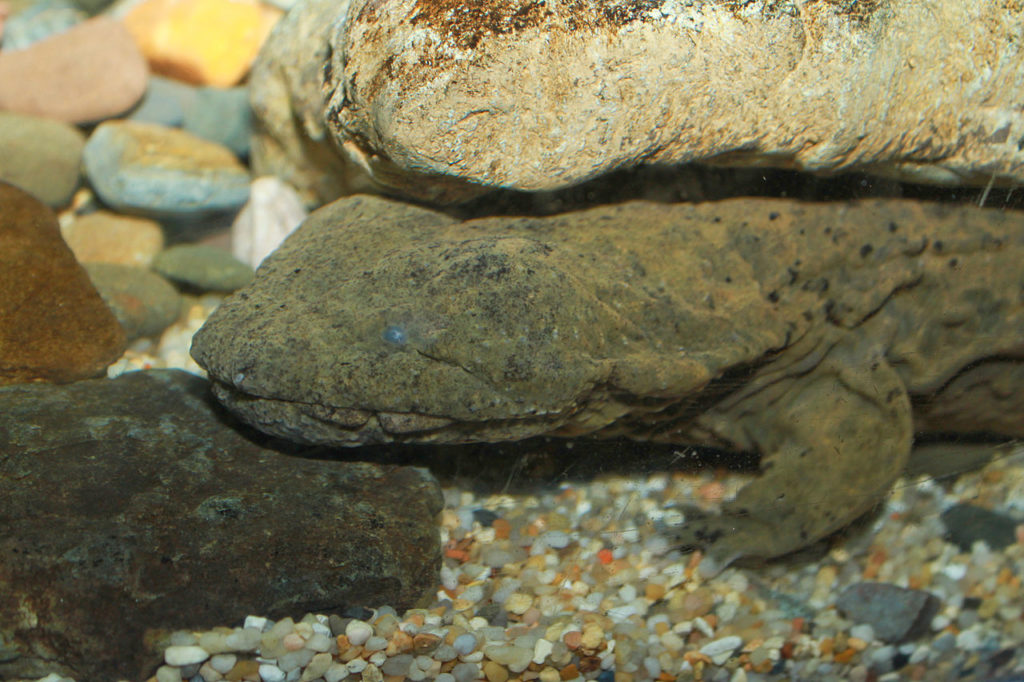Hellbender facts, pictures and in-depth information. Reaching almost two and a half feet in length, the hellbender is the largest amphibian found in North America. This slimy-skinned giant may look like a monster, but in fact is harmless to humans and a vital part of the river ecosystem. The Ozark subspecies has been listed as endangered under the Endangered Species Act in the USA since 2011.
Hellbender Facts At A Glance
- Other Name(s): Hellbender salamander, mud devil, devil dog, snot otter
- Scientific name: Cryptobranchus alleganiensis
- Type of Animal: Amphibian
- Animal Family: Cryptobranchidae
- Where Found: Eastern United States
- Length (including tail): 30 - 74 cm (12 - 29 in.)
- Weight:5 - 2.5 kg (3.3 - 5.5 lb.)
- Conservation Status: Vulnerable
Other interesting Hellbender facts:
- The hellbender is world’s fourth largest living amphibian, and the largest amphibian in North America.
- A mature hellbender gets most of the oxygen it needs through its skin.
- There are two subspecies of hellbender, the eastern hellbender and the Ozark hellbender.
- The hellbender’s IUCN conservation status is Vulnerable. In the USA the Ozark subspecies is listed as an endangered species.
Hellbender Video
You can see conservationists handling wild hellbenders in the video below:
Meet The Hellbender: Introduction
The hellbender is a large salamander found in fast-flowing rivers and streams in the eastern United States. Reaching up to 29 inches (74 cm) in length, the hellbender is the largest amphibian in North America, and the fourth-largest in the world.
(The only amphibians larger than the hellbender are the Chinese giant salamander, the Japanese giant salamander and the goliath frog.)
How To Recognize A Hellbender
An average adult hellbender is between 12 and 15 inches (30 to 38 cm) in length.
The hellbender is easily distinguished from other salamanders due to its large size and the flattened shape of its body and head. The tail is long and paddle-like.
The hellbender’s skin is various shades of brown / copper-brown, and has a mottled appearance. The skin is slimy and moist to the touch.
On either side of an adult hellbender’s head is a gill slit.
Running along either side of the hellbender’s body are long frills of wrinkled skin. These frills serve to increase the surface area of the hellbender’s body. The hellbender is able to ‘breathe’ through its skin, and the frills are full of capillaries (tiny blood vessels) that absorb oxygen from the water.
The hellbender has four toes on each of its front feet, and five on each of its hind feet. Each of the hellbender’s toes has a hardened tip. These help the hellbender to grip and move around on the rocky river bed.
Hellbender Family And Related Species
The hellbender is a salamander. Salamanders make up an order (group) of amphibians called Urodela.
The hellbender is in the family Cryptobranchidae, which is otherwise known as the ‘giant salamanders’. There are only three species in this family: the hellbender, the Japanese giant salamander (Andrias japonicus) and the Chinese giant salamander (Andrias davidianus).
You can learn more about terms such as ‘order’ and ‘family’ here: Animal Classification Guide
Hellbender Metamorphosis
Like most amphibians, the hellbender undergoes a process called metamorphosis that sees its body change from its infant into its adult form. Hellbenders undergo metamorphosis when they are around 18 months old.
Most amphibians begin life as aquatic animals (i.e. animals that live in the water) equipped with gills.
During metamorphosis an amphibian’s gills are absorbed into its body and it develops lungs that enable it to breathe air.
After metamorphosis many amphibians begin to spend time away from the water.
Infant hellbenders have external gills that look like small trees growing out of either side of their heads.
Although the hellbender remains in the water in its adult form, like most amphibians it does lose its gills and gains lungs.
Do Hellbenders Breathe Air?
Unlike some salamanders, hellbenders are fully aquatic and never (or, at least, very rarely) leave the water.
Although they have lungs, mature hellbenders obtain most of the oxygen they need through their skin. However, the lungs are functional, and are used when the hellbender can’t obtain enough oxygen from the water.
Studies have found that hellbenders are able to survive without their lungs.
In the video below YouTube animal expert Coyote Peterson comes face to face with a hellbender!
Where Does The Hellbender Live?
The hellbender is endemic to (i.e. only found in) the United States. It is found in the east of the country.
The hellbender is present in the following states: Alabama, Arkansas, Georgia, Illinois, Indiana, Iowa, Kansas, Kentucky, Maryland, Minnesota, Mississippi, Missouri, New York, North Carolina, Ohio, Pennsylvania, South Carolina, Tennessee, Virginia, and West Virginia.
The Ozark hellbender subspecies is only found in a few locations in Missouri and Arkansas.
Hellbender Habitat
Hellbender Behavior
The hellbender is most active at night. During the day it spends most of the time sheltering under boulders and rocks. Under the cover of darkness it emerges from its hiding place in order to hunt.
The hellbender is territorial, and will defend its patch from other hellbenders throughout the year.
Hellbender Diet
The hellbender is a predator. Its main prey is crayfish, but it will also eat fish, insects, snakes, tadpoles, toads. The hellbender is cannibalistic, and will prey on other hellbenders and also on hellbender eggs.
Hellbender Life Cycle
In late summer / early fall, the male hellbender excavates a round hole underneath a flat rock or submerged log. When a female approaches, he will shepherd her into the nest he has created.
The female lays between 100 and 500 eggs in the nest before leaving. The eggs are between 0.7 and 0.8 in. (1.8 to 2 cm) in diameter and are laid in double strands.
While the female is laying the eggs, the male fertilizes them by spraying them with sperm. The male will tempt multiple females into his nest during the breeding season.
The male guards the nest as the eggs develop. After around 2 months the eggs will hatch. The young hellbenders are around 2.5 cm (1 in.) long and have external gills.
At around 18 months of age, the infant hellbender will metamorphose into its adult form. It will reach sexual maturity at around 5 – 8 years.
Hellbender Lifespan
The hellbender is known to live up to 25 – 30 years in the wild.
Hellbender Predators
The adult hellbender is most often the hunter rather than the hunted. However, it will fall prey to raccoons, minks and otters. The hellbender is also occasionally accidentally hooked by pleasure anglers.
Juvenile hellbenders are preyed on by numerous predators, including fish, turtles, snakes and other hellbenders.
Is The Hellbender Endangered?
In 2022, the IUCN (International Union for Conservation of Nature) changed the conservation status of the hellbender from "Near Threatened" to "Vulnerable" due to the species' continued decline.
In 2011, the US Fish and Wildlife Service listed the Ozark hellbender subspecies as an endangered species under the Endangered Species Act.
Hellbender Threats
The primary threats to the hellbender are habitat loss and habitat degradation. The species is highly specialized, and unable to adapt to changes to its habitat.
The hellbender requires fast-flowing, clear, rocky water. Dams, road building and other industrial activities can slow the flow of water and cause silt build up, both of which are detrimental to the hellbender.
Secondary threats include hunting, and the collection of hellbenders for pets. Heavy recreational use of a waterway (e.g. heavy canoe traffic and angling) can also cause hellbenders to leave an area.
Hellbender Facts: Related Articles
You can find out about other amazing amphibians in the following articles:
- Cane Toad Facts
- Caecilian Facts
- American Bullfrog Facts
- Rabb’s Fringe-Limbed Tree Frog Facts
- Golden Poison Frog Facts
Discover more about the animal kingdom:








this is a great website